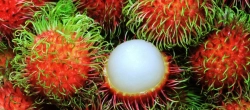Mango: Taste, Uses, Benefits and Harm
Often called the “king of fruits,” mango is one of the most popular tropical fruits, celebrated for its rich flavor and variety of types. Its sweetness and juiciness make it a staple in many cuisines, from India to Latin America. In this article, we explore the flavor characteristics of mango, its culinary applications, health benefits, and tips on selecting and storing it.

Key Flavor Characteristics
Mango has a bright, sweet taste with rich tropical notes and a hint of acidity. The specific flavor can vary depending on the variety and ripeness, with some mangoes tasting sweeter, while others may have a slightly sour or spicy undertone.
Aromatic Compounds
Mango’s aroma is created by terpenes, which give it a characteristic fruity-floral scent. Notable compounds include myrcene, which adds to its tropical, slightly piney fragrance.
Scientific Description of Taste and Aroma
- Aroma: Vibrant, floral, with citrus and slight pine undertones.
- Taste: Sweet, with tropical flavors and a hint of tartness.
- Texture: Juicy and soft, with some varieties having a fibrous texture.
In-depth Flavor Analysis of Mango
Underlying Flavor Notes
Mango has a vibrant and complex taste profile with several layers:
- Tropical Sweetness: Mango’s primary flavor is intensely sweet, with a tropical essence that makes it distinctly refreshing and juicy.
- Citrus and Pine Notes: Many varieties of mango have faint citrus notes, adding a bright, zesty edge, and a subtle pine-like quality that enhances the depth of flavor.
- Creamy Undertones: Ripe mangoes have a smooth, almost buttery sweetness, which adds a creamy mouthfeel to the taste experience.
Impact of Ripeness on Flavor
- Unripe Mango: Tart and firm, unripe mango has a sharp, acidic taste that lends itself well to pickles, salads, and savory dishes.
- Fully Ripe Mango: As the mango ripens, it develops a rich sweetness and juicy texture, with tropical, floral, and slightly honeyed notes, making it ideal for desserts and fresh eating.
Texture Characteristics
Mangoes are known for their silky, juicy flesh. The texture can range from firm and crunchy in unripe mangoes to soft and tender in ripe ones. Some varieties also have slight fibrous strands, adding a subtle textural complexity when eaten fresh or used in smoothies.
Culinary Uses of Mango
Primary Uses
- Fresh Mango: Eaten as a dessert, added to salads, or used in smoothies for a tropical twist.
- Juices and Cocktails: Mango’s sweetness makes it an ideal base for fresh juices, cocktails, and fruit blends.
- Desserts: Commonly used in sorbets, ice creams, cakes, and other sweets.
- Salads and Appetizers: Mango pairs well with vegetables and seafood, adding balance and exotic notes to dishes.
- Asian Cuisine: In Thai and Indian cooking, mango is used in sauces, chutneys, and marinades. Unripe mango is also used in salads and curries, adding a refreshing tartness.
Ideal Pairings for Mango
- Citrus Fruits: Lime and orange highlight mango’s sweetness and enhance its tropical notes.
- Seafood: Shrimp, crab, and fish gain extra flavor and aroma when paired with mango.
- Vegetables: Cucumber, avocado, and bell pepper add freshness and lightness to mango-based salads.
- Spices: Chili, mint, cilantro, and basil enhance mango’s sweetness and provide a contrasting flavor.
- Dairy Products: Yogurt, cottage cheese, cream, and ice cream pair well with mango, adding a creamy texture and balancing its acidity.
Health Benefits of Mango
Key Nutrients and Benefits
- Vitamin C: Mango is rich in vitamin C, supporting immune health and skin.
- Vitamin A: Vitamin A and beta-carotene promote eye health and healthy skin.
- Antioxidants: Beneficial antioxidants, such as quercetin and gallic acid, protect cells from damage.
- Dietary Fiber: Helps improve digestion and maintain healthy blood sugar levels.
Potential Precautions
- Allergic Reactions: Some people may be allergic to mango; it is recommended to consume it with caution.
- High Sugar Content: Ripe mangoes contain a lot of natural sugars, so individuals with diabetes should enjoy them in moderation.

Tips for Selecting and Storing Mango
How to Select Quality Mango
- Ripeness: Ripe mangoes have a soft texture when gently pressed and an intense aroma. The color can range from yellow to red, depending on the variety.
- Smell: A strong, sweet aroma at the stem end indicates ripeness.
- Surface: Ripe mangoes have smooth skin without spots or blemishes.
Storage Recommendations
- Fresh Mango: Unripe mangoes can be kept at room temperature to ripen, while ripe ones should be stored in the refrigerator to extend freshness.
- Freezing: Mango can be diced and frozen for later use in smoothies and desserts.
- Dried Mango: Dried mango pieces retain their flavor and are great for snacking or adding to baked goods.
Fun Facts About Mango
- History and Origin: Mango originated in Southeast Asia and is one of the oldest cultivated fruits known to humanity.
- Varietal Diversity: There are over 500 varieties of mango, each with unique taste and aroma characteristics.
- Cultural Significance: In India, mango is considered a sacred fruit and a symbol of love and prosperity.









